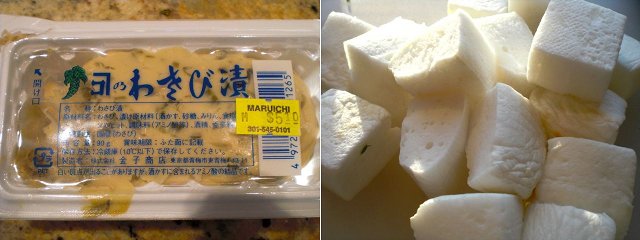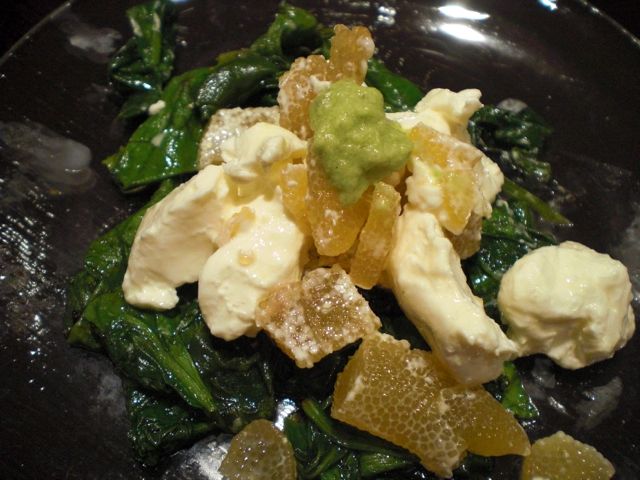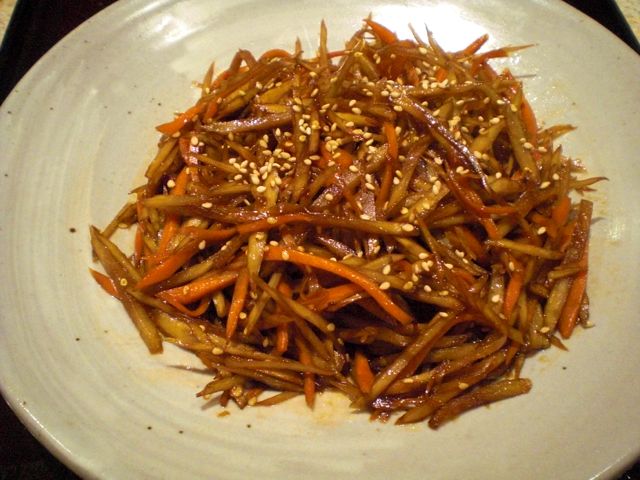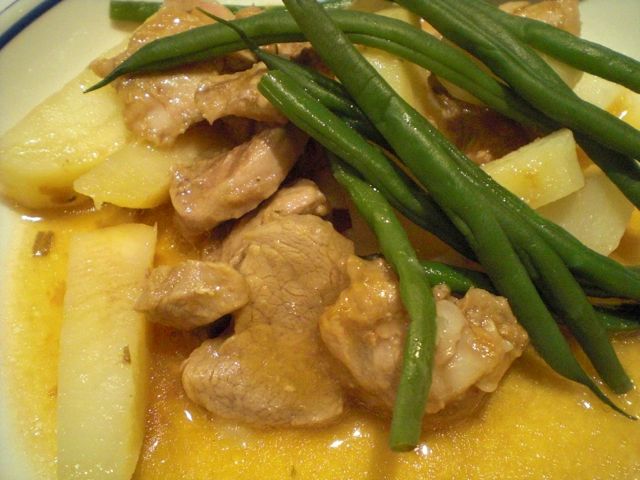Tuesday, January 24, 2012
Hanpen fish cake dressed in wasabi sake lee ハンペンの山葵漬け和え
This may look like cubes of tofu but this is a type of fish cake called "hanpen" ハンペン. I posted a few items using this. This fish cake is made of white fish meat and egg white and looks snow white. In shizuoka 静岡, "kuro hanpen" or black hanpen is famous in which sardine meat is used and dark colored. Instead of being deep fried, hanpen is usually steamed. As a result, it is soft and very mild in taste.
 In the U.S., the best hanpen available is the "Kibun" 紀文 brand which comes frozen (see below).
In the U.S., the best hanpen available is the "Kibun" 紀文 brand which comes frozen (see below).
 I happened to have "Wasabi zuke" 山葵漬け which came in a plastic tab frozen (image below left). I am sure it is not as good as the ones available in Japan especially in Shizuoka 静岡 but this has to do in the U.S.. You could just add soy sauce and nibble it as you sip sake or use it as a condiments for cold tofu, "Chikuwa" 竹輪 fish cake or anything else. Since I found hanpen in our freezer (from the New Year's purchase I am sure), I decided to have this as a drinking snack. I first defrosted it in a microwave oven and then grilled it in a toaster oven to make it plump up and very slightly brown the surface. I cut the hanpen into small cubes (image below right). I then made a mixture of wasabi zuke and soy sauce and dressed the hanpen cubes.
I happened to have "Wasabi zuke" 山葵漬け which came in a plastic tab frozen (image below left). I am sure it is not as good as the ones available in Japan especially in Shizuoka 静岡 but this has to do in the U.S.. You could just add soy sauce and nibble it as you sip sake or use it as a condiments for cold tofu, "Chikuwa" 竹輪 fish cake or anything else. Since I found hanpen in our freezer (from the New Year's purchase I am sure), I decided to have this as a drinking snack. I first defrosted it in a microwave oven and then grilled it in a toaster oven to make it plump up and very slightly brown the surface. I cut the hanpen into small cubes (image below right). I then made a mixture of wasabi zuke and soy sauce and dressed the hanpen cubes.
 My wife was surprise by the texture since she thought this was tofu. It is a bit spongy in texture but it has a nice gentle taste. The taste was enhanced by the wasabi zuke which has a slight sweetness from the sake lee with a tang from the wasabi plants (stalks and leaves). A simple and good starter dish in a home Izakaya.
My wife was surprise by the texture since she thought this was tofu. It is a bit spongy in texture but it has a nice gentle taste. The taste was enhanced by the wasabi zuke which has a slight sweetness from the sake lee with a tang from the wasabi plants (stalks and leaves). A simple and good starter dish in a home Izakaya.
Sunday, January 22, 2012
Herring roe and cream cheese with wasabi 数の子クリームチーズ和え
Whenever we get herring roe or Kazunoko 数の子 for New Year, we have to finish it by the end of the first week of the year before it gets spoiled. Eating it just "as is" sometimes gets old so I tried to come up with different ways to serve kazunoko. Apparently other people think along similar lines as evidenced by this recipe.
 The recipe calls for small cubes of kazunoko and cream cheese served on the bed of greens. For greens, I used baby spinach slightly sautéed (wilted) in butter and seasoned with salt and black pepper. I am not sure if the cream cheese (American invention) in Japan is different from the U.S. version--Philadelphia cream cheese, but my version was soft even straight from the cold refrigerator. As a result, I could not make neat cubes from it. I added a dab of real wasabi but did not add any soy sauce since the kazunoko had enough saltiness.
The recipe calls for small cubes of kazunoko and cream cheese served on the bed of greens. For greens, I used baby spinach slightly sautéed (wilted) in butter and seasoned with salt and black pepper. I am not sure if the cream cheese (American invention) in Japan is different from the U.S. version--Philadelphia cream cheese, but my version was soft even straight from the cold refrigerator. As a result, I could not make neat cubes from it. I added a dab of real wasabi but did not add any soy sauce since the kazunoko had enough saltiness.
This is a nice small dish which goes well with sake. The combination of crunchy kazunoko and soft cream cheese gives a nice contras
Saturday, January 21, 2012
Norio on wine and food cookbook 2011
We just received copies of NOWAF cookbook 2011 edition. This is the first time that one of the NOWAF cookbooks contains the posts of an entire year--2011 from Jan 1 to Dec 31.
If you are interested in browsing through, it is on the NOWAF cookbook section of this blog.
As we said before, having a hard cover copy in our hands feels more substantial than seeing it on the screen. In any case, thumbing through it brings back memories associated with the food and reminds us of some dishes we completely forgot. I am not sure how long I can keep this up. I may have to slow down or be more selective about what I post but as long as I can come up with another Izakaya dish, I will share it with you. Some people eat to live but how boring is that? I'd rather live to eat.
Friday, January 20, 2012
Burdock root "gobou" three ways ごぼうの杣(そま)揚げ、チップス、きんぴら
For the New Year, I bought some burdock roots or gobou 牛蒡. One package contained two roots, which is a lot. So, after I used a portion for the New Year's dishes, I needed to finish up the remaining gobou. One evening I made these three gobou dishes.

Batter: I used buckwheat flour (2-3 tbs) and a pinch of salt. I added enough cold water to make a rather thick batter.
 *Later, I located this old cook book of drinking snacks by Shino Ikenami 池波志乃 called "Drinking snacks extraordinary" or 酒肴とびっきり and looked up the dish I made. It turns out I was actually, combining two of her recipes; one is tempura of "mountain" vegetables 山菜 using buckwheat flour batter and another is the original form of this dish; "gobou no soma-age" 牛蒡の杣揚げ, in which she used regular tempura batter. Although no new printing is being produced, surprisingly, this book (used) is still available (It was published in 1983).
*Later, I located this old cook book of drinking snacks by Shino Ikenami 池波志乃 called "Drinking snacks extraordinary" or 酒肴とびっきり and looked up the dish I made. It turns out I was actually, combining two of her recipes; one is tempura of "mountain" vegetables 山菜 using buckwheat flour batter and another is the original form of this dish; "gobou no soma-age" 牛蒡の杣揚げ, in which she used regular tempura batter. Although no new printing is being produced, surprisingly, this book (used) is still available (It was published in 1983).
 This is like potato chips but gobou has a much more earthy nutty flavor. This fried up nicely and was not oily at all. It was nicely light and crunchy.
This is like potato chips but gobou has a much more earthy nutty flavor. This fried up nicely and was not oily at all. It was nicely light and crunchy.
This is by far the most popular preparation of gobou. It is a classic and still excellent. I have posted this before and will not repeat myself.
 We had these three gobou dishes with California cab, Consentino 2005. This wine has a rather classic flavor profile of Califronia Cab in a good way. After tasting some austere Italian wines, we had to admit we like California reds like this one much better. This wine has a nice black and red fruit upfront with dark chocolate and vanilla with spices and moderate tannin.
We had these three gobou dishes with California cab, Consentino 2005. This wine has a rather classic flavor profile of Califronia Cab in a good way. After tasting some austere Italian wines, we had to admit we like California reds like this one much better. This wine has a nice black and red fruit upfront with dark chocolate and vanilla with spices and moderate tannin.
Preparation of gobou is the same for all three dishes. The only difference is the shape of the pieces. I first halved the length of gobou since it is rather long and awkward to handle. Under running water, using the back of a vegetable cleaver or nakiri 菜切り包丁, I scraped off the dark skin. Depending on which dish I was making I cut the pieces differently but as soon as I cut the pieces, I soaked them in acidulated (with rice vinegar) water. Before using, I washed the pieces in cold water and dried them well using paper towels.
1. Soma-age 杣揚げ
The first one below is called "soma-age". "Soma" 杣 means wood or lumber cut from a mountain and the resemblance of this dish to the name-sake is rather obvious. I somehow remembered this dish from the depth of my memory (old drinking snack cook book*). It is like tempura but buckwheat flour or sobako そば粉 is used, which gives a nice crunchy texture and nutty flavor to this dish. It is a variation of gobou karaage 牛蒡の唐揚げ but it is different enough to warrant a different name.
I cut the gobou into 2 inch long pieces and then halved it lengthwise. I then placed the cut side down and sliced it rather thinly (2-3 mm or 1/5 inch) lengthwise. The central pieces were too wide so I cut them in half again lengthwise producing match sticks of gobou. After soaking them in acidulated water for 10 minutes, I washed them in fresh cold water, then patted them dry with paper towels.
Batter: I used buckwheat flour (2-3 tbs) and a pinch of salt. I added enough cold water to make a rather thick batter.
Frying: I individually coated the gobou sticks and deep fried them in 340F peanut oil for one minute or until done and drained them over several layers of paper towels.
This is best eaten while hot. The buckwheat crust and fried gobou are indeed a winning combination. We like this variation better than kara-age, although both are excellent Izakaya food.
2.gobou chips 牛蒡チップス
This is rather straight forward. I just sliced gobou on a slant rather thinly (paper thin). After soaking in acidulated water, I rinsed them and then patted them dry with paper towels. I simply deep fried the pieces for less than a minute in 320-330F peanut oil until brown and crispy turning once. While it was draining on the paper towel, I sprinkled on kosher salt.
3 Stir fried "Kimpira" burdock root 金平牛蒡
This is by far the most popular preparation of gobou. It is a classic and still excellent. I have posted this before and will not repeat myself.
Somehow this was a perfect wine with the gobou dishes. This red particularly went swimmingly with the "soma-age" burdock. Although I had to admit, these dishes will go well with beer or sake as well.
Wednesday, January 18, 2012
Steamed potato and pork tenderloin with pickled plum sauce ジャガイモと豚肉の梅が香蒸し
Whenever we cook pork tenderloin, we have trimmings left. From the trimmings, I make many other dishes such as gyoza, pork scallopini etc. I then saw this recipe in Asahi shinbun on line and decide to try it. This is potato and pork tenderloin in a pickled plum (or umeboshi 梅干) sauce which is steamed. This is in a category similar to our steamed lemon chicken with shiitake mushrooms. This is a rather healthy dish and it turned out to be very nice. This dish definitely will join in our teiban 定番 or regular dishes.
 I made some modifications to the dish but they were not intentional; they just happened. Otherwise, I followed the recipe. The above is the final product and this will probably serve 4.
I made some modifications to the dish but they were not intentional; they just happened. Otherwise, I followed the recipe. The above is the final product and this will probably serve 4.
Potato: We used white potatoes (4 medium). Peeled and cut it in 1/3 inch wide batons like for French fries. I soaked them in cold water to remove the excess starch on the surface and then dried them using a paper towel. I seasoned them with salt and coated with olive oil (2 tbs).
Pork tenderloin: These were the trimmings from 2 pork tenderloins. I did not weigh them but I estimate it was about 4-500 grams (about 1 lb). I sliced them into 1/3 inch medallions.
Potato: We used white potatoes (4 medium). Peeled and cut it in 1/3 inch wide batons like for French fries. I soaked them in cold water to remove the excess starch on the surface and then dried them using a paper towel. I seasoned them with salt and coated with olive oil (2 tbs).
Plum sauce: I removed the meat from umeboshi or pickled plum (2) and minced it to make a paste. I mixed in soy sauce (2 tbs), mirin (1tbs), sake (1 tbs), sugar (2 tsp), dark sesame oil (2 tbs) and potato starch (2 tbs). I also added grated ginger (1/4 tsp) and grated garlic (1/2 tsp). The grated garlic was my addition, I thought I had grabbed a tube of ginger but discovered after I had put it in that it was garlic. Turns out that it added a very interesting dimension that really added to the dish.
I placed the pork tenderloin from above and mixed and marinated it in the sauce for few minutes.
Assembly: I used a deep pasta dish and made alternate layers of the potato and the pork with potato layers on the bottom and top with two pork layers.
I steamed it on medium high flame for about 30 minutes. At the last few minutes, I added haricot verts (we happened to have ones already steamed from the other night). I think any greens will do here.

We served portions as shown in the picture. This is a very good dish that could quickly enter the "comfort food" category. The pork is very tender and potato and the sauce which forms during the steaming goes so well together. The sauce has a subtle sourness from the pickled plum. My (inadvertent) addition of garlic was also good. The only problem we had was that the potato cooked a bit unevenly.
Monday, January 16, 2012
Tuna bowl 鉄火丼
"Tekka" 鉄火 in Japanese literally means "iron fire" describing red hot iron. When the red meat of tuna sashimi is used in a "maki" roll or "donburi" rice bowl dish, they are called "tekkamaki" 鉄火巻き and "tekkadon" 鉄火丼, respectively. Here, the red tuna sashimi is equated with red hot iron. One weekend, I made this as a lunch.
I also made miso soup with wakame, deep fried tofu pouch or abura-age 油揚げ, and scallions. This is a simplest form of this type of dish but very satisfying. A good lunch for any day.
Again, this is not a recipe per se but just a description of how I assembled the dish.
Tuna: From a pound block of tuna sashimi, I sliced red meat or 赤身 in relatively thin slices like one would use to make nigiri sushi. I smeared on a small amount of real wasabi exactly like I would do to make nigiri sushi.
Sushi rice: Since this was a lunch, I did not make fresh rice. I microwaved frozen rice in a silicon container and added sushi vinegar (from the bottle). After mixing, I put the lid back on the container and let it steep for a few minutes so that the sushi vinegar was nicely absorbed.
I placed the sushi rice in the bowls and placed the tuna sashimi (with wasabi smeared side down). Since I had a nicely ripe avocado, I sliced it and placed next to the tuna. I sprinkled soy sauce on the top and garnished with roasted white sesame and nori strips.
Saturday, January 14, 2012
Tuna "chiai" cake 鮪の血合いバーガー
The block of sashimi-grade tuna we got from Catalina Offshore products contained a dark red portion called "chiai" 血合い or blood line. This very dark meat is the least desirable part of the entire tuna. It has a strong gamy taste. Many sushi bars throw out this portion (or I imagine they may serve it to the employees) but, I have made two similar dishes using chiai, which were not bad. This time, I decide to make something totally different.

 This was a starter dish. The amount of chiai from the one pound tuna block this time was not much. I could only make two small tuna patties or cakes.
This was a starter dish. The amount of chiai from the one pound tuna block this time was not much. I could only make two small tuna patties or cakes.
I sautéed a shallot (one small, finely chopped) in light olive oil for few minutes. I placed it in a metal bowl to cool before I added the other ingredients which included finely chopped parsley (3 springs, finely chopped), ginger and garlic (grated 1/2 tsp each), store-bought mayonnaise (1 tbs) and panko bread crumbs (1 tbs). I seasoned it with salt and pepper. I could have added more items such as lemon zest, hot pepper (either Tabasco or finely chopped jalapeño), but I restrained myself.
I made two equal sized patties and fried them in olive oil 2-3 minutes on both sides. I served it with mixed green and my salad dressing which is balsamic vinegar, mustard, olive oil and rice vinegar.
Tuna chiai: I just chopped into small cubes.
I sautéed a shallot (one small, finely chopped) in light olive oil for few minutes. I placed it in a metal bowl to cool before I added the other ingredients which included finely chopped parsley (3 springs, finely chopped), ginger and garlic (grated 1/2 tsp each), store-bought mayonnaise (1 tbs) and panko bread crumbs (1 tbs). I seasoned it with salt and pepper. I could have added more items such as lemon zest, hot pepper (either Tabasco or finely chopped jalapeño), but I restrained myself.
I made two equal sized patties and fried them in olive oil 2-3 minutes on both sides. I served it with mixed green and my salad dressing which is balsamic vinegar, mustard, olive oil and rice vinegar.
I was afraid that chiai may be too strong for this dish but the addition of a good amount of ginger and garlic really helped. This was a perfectly good use of scrap meat from the tuna block which would have been discarded in most circumstances.
Subscribe to:
Comments (Atom)


